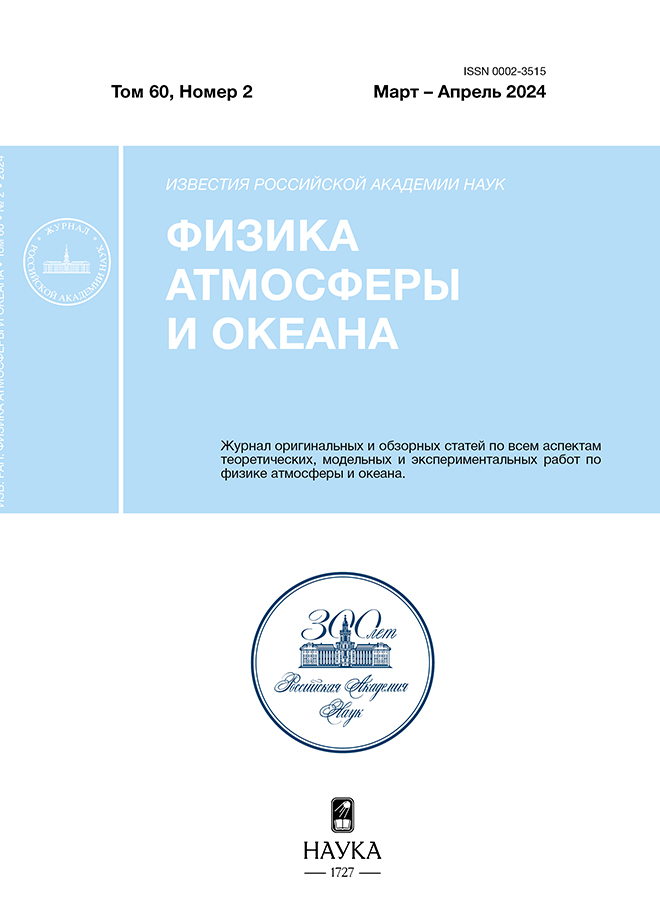Analysis of noctilucent clouds’ fields according to ground-based network and airborne photography data
- Authors: Pertsev N.N.1, Dalin P.A.2,3, Perminov V.I.1, Gusev N.K.4, Tsimerinov E.Y.5, Solodovnik A.A.6, Zadorozhny A.M.7, Korotyshkin D.V.8, Bordonskiy G.S.9
-
Affiliations:
- Obukhov Institute of Atmospheric Physics RAS
- Swedish Institute of Space Physics
- Space Research Institute RAS
- Zavolzhsk City Museum of Art and Local Lore
- Noctilucent Clouds Observing and Study Center
- Kozybayev North Kazakhstan University
- Novosibirsk State University
- Kazan (Privolzhskiy) Federal University
- Institute of Natural Resources, Ecology and Cryology SB RAS
- Issue: Vol 60, No 2 (2024)
- Pages: 221–228
- Section: Articles
- URL: https://journals.eco-vector.com/0002-3515/article/view/658359
- DOI: https://doi.org/10.31857/S0002351524020089
- EDN: https://elibrary.ru/KPZIIG
- ID: 658359
Cite item
Abstract
The article analyzes the fields of noctilucent clouds over the territory of the Russian Federation, recorded by a ground-based network of cameras using also aircraft photography, over the two nights in June 2021. It is demonstrated that aircraft photography can significantly improve the coverage of the territory of noctilucent clouds’ probable appearance. The detected noctilucent cloud fields are compared with model regions of water vapor condensation derived from satellite measurements of temperature and water vapor mixing ratio. Practical steps are proposed for the development of aircraft observations of noctilucent clouds.
Full Text
About the authors
N. N. Pertsev
Obukhov Institute of Atmospheric Physics RAS
Author for correspondence.
Email: n.pertsev@bk.ru
Russian Federation, 119017, Moscow, Pyzhevskiy per., 3
P. A. Dalin
Swedish Institute of Space Physics; Space Research Institute RAS
Email: n.pertsev@bk.ru
Sweden, SE-981 28, Kiruna, Box 812; 117997, Russia, Moscow, Profsoyuznaya str., 84/32
V. I. Perminov
Obukhov Institute of Atmospheric Physics RAS
Email: n.pertsev@bk.ru
Russian Federation, 119017, Moscow, Pyzhevskiy per., 3
N. K. Gusev
Zavolzhsk City Museum of Art and Local Lore
Email: n.pertsev@bk.ru
Russian Federation, 155412, Zavolzhsk, Frunze str., 2
E. Yu. Tsimerinov
Noctilucent Clouds Observing and Study Center
Email: n.pertsev@bk.ru
Russian Federation, 117452, Moscow, Chongarskiy boul., 21
A. A. Solodovnik
Kozybayev North Kazakhstan University
Email: n.pertsev@bk.ru
Kazakhstan, 150000, Petropavlovsk, Zhumabaeva str., 114
A. M. Zadorozhny
Novosibirsk State University
Email: n.pertsev@bk.ru
Russian Federation, 630090, Novosibirsk, Pirogova str., 2
D. V. Korotyshkin
Kazan (Privolzhskiy) Federal University
Email: n.pertsev@bk.ru
Russian Federation, 420008, Kazan, Kremlevskaya str., 18
G. S. Bordonskiy
Institute of Natural Resources, Ecology and Cryology SB RAS
Email: n.pertsev@bk.ru
Russian Federation, 672014, Chita, Nedorezova str., 16a
References
- Бронштэн В.А. Серебристые облака и их наблюдение. М.: Наука, 1984. 128 с.
- Бронштэн В.А., Гришин Н.И. Серебристые облака. М.: Наука, 1970. 359 с.
- Гришин Н.И. О структуре серебристых облаков // Астрономический Циркуляр. 1954. Т. 147. С. 20−24.
- Dalin P., Pertsev N., Zadorozhny A., Connors M., Schofield I., Shelton I., Zalcik M., McEwan T., McEachran I., Frandsen S., Hansen O., Andersen H., Sukhodoev V., Perminov V., Romejko V. Ground-based observations of noctilucent clouds with a northern hemisphere network of automatic digital cameras // J. Atmos. Sol.-Terr. Phys. 2008. V. 70. P. 1460–1472.
- Dalin P., Pertsev N., Dubietis A., Zalcik M., Zadorozhny A., Connors M., Schofield I., McEwan T., McEachran I., Frandsen S., Hansen O., Andersen H., Sukhodoev V., Perminov V., Balčiunas R., Romejko V. A comparison between ground-based observations of noctilucent clouds and Aura satellite data // J. Atmos. Sol.-Terr. Phys. 2011. V. 73. P. 2097–2109.
- Dalin P., Pertsev N., Perminov V., Efremov D., Romejko V. Stratospheric observations of noctilucent clouds: a new approach in studying middle and large-scale mesospheric dynamics// Ann Geophys. 2020. V. 38. P. 61–71.
- Dubietis A., Dalin P., Balciunas R., Cernis K., Pertsev N., Sukhodoev V., Perminov V., Zalcik M., Zadorozhny A., Connors M., Schofield I., McEwan T., McEachran I., Frandsen S., Hansen O., Andersen H., Grønne J., Melnikov D., Manevich A., Romejko V. Noctilucent clouds: modern ground-based photographic observations by a digital camera network // Appl. Opt. 2011. V. 50. № 28. P. F72–F79.
- Gadsden M., Schröder W. Noctilucent clouds. New York: Springer-Verlag, 1989. 165 p.
- Suzuki H., Matsumoto A., Dalin P., Nakamura Y., Ishii S., Sakanoi K., Sakaguchi K., Takada T., Tsuda T.T., Hozumi Y. Capability of airline jets as an observation platform for noctilucent clouds at middle latitudes // Progress in Earth and Planetary Science. 2022. V. 9. № 11. 10 p. https://doi.org/10.1186/s40645-022-00469-4
Supplementary files













